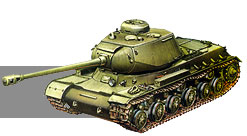


Translation
- CialisBesstelen
- 1 member
- 21 guests
- 6 robots
Visitors
| Today: | 2506 |
| Yesterday: | 2511 |
| This Week: | 5017 |
| Last Week: | 16873 |
| This Month: | 51228 |
| Last Month: | 63549 |
| Total: | 136957 |
JS-3 Heavy Tank |
 |
 |
Created Tuesday, 20 September 2005 18:05
|
|||
Last Updated on Saturday, 09 January 2010 14:47
|
|||
|
A new «Kirovets-1» Heavy Tank project commenced in summer 1944. This project was undertaken after a detailed examination was performed of the types and locations of battle damage inflicted by German antitank weapons on Soviet armored vehicles. There were, in fact, two different heavy tank projects being developed under two competing engineering groups: one group led by The first project was based on Objects #244, #245, and #248. The main feature of this project was the unusual frontal armor (glacis). It consisted of two plates welded at an angle, which sloped down from the center on both sides. Designers called this feature a «pike's nose», while western sources call it simply a «Pike.» All previous tanks had flat frontal armor built from a single plate. The old version had two crewmen at the front of the tank: the driver and the radio operator. By removing the radio operator's position, the driver could be relocated to the center. This allowed the tank designers to reconfigure the sides of the glacis, creating two sloping The hull of the JS-3 was welded as opposed to being cast, as most foundries were already occupied with the manufacture of turrets for the JS-2 and the T-34. At the same time, the latest advances in welding technology allowed for welded hulls of robust construction. The second project was noted for its unusually rounded turret, fitted with a powerful 122 mm D-25T Tank Gun. This rounded turret, shaped like an inverted soup bowl, resembles modern Soviet turret design. The sloped shape deflected enemy Both projects were shown to In October 1944, the first prototype named «Object 703» was shown to The JS-3 Heavy Tank (or its working «Object 703» designation) as approved, boasted a very good hull and turret, with excellent armor protection. The sloped armor on the turret and hull allowed better overall protection of the tank. The rear armor plate was sloped rearwards. The centered driver's position was fitted with a The semi-automatic The JS-3 carried four internal steel fuel tanks with a total capacity of The first test group of JS-3's left the factory gates in On September 7, 1945, a united Allied military parade was held in Berlin. The parade began with infantry columns: Soviet soldiers of the 9th Rifle Corps of the 5th Shock Army, then soldiers of the French 2nd Infantry Division, Alpine troops, and Zoaves. There was a brilliant display by the British 131st Infantry Brigade. Paratroopers of the US 82nd Airborne Division brought up the rear. After a short break, a continuous mechanized column started. The first vehicles were In the USSR, JS-3 was introduced during a military parade on November 7, 1946. For the sake of accuracy, JS-3 were in mass production until mid-1946. Overall, there were 2,311 tanks manufactured. Unfortunately, at the beginning of its career, the JS-3 suffered from many serious problems related to design flaws. The most serious were: an unreliable engine, an extremely unreliable From After all modifications, weight of JS-3 had increased up to 48.8 tones. Despite all the changes and expenses of modernisation tank still had many deficiencies and remained unreliable. At the end of the 1950's, tank was modernised again and received a new designation: JS-3M. In fact, modernised tanks were more or less comparable with other Soviet and western tanks. Unfortunately, the JS-3 had had its day, and after the modernisation, all of the tanks were sent to storage areas and JS-3 tanks were exported in limited numbers. In 1946, two tanks were sent to the Polish Army for evaluation and instructor training. Probably, the Poles planned to accept the JS-3 for service in the future. In 1950, one tank was sent to Czechoslovakia. China received many more tanks (they arrived after the Korean War). The Egyptian army received the first three JS-3's at the end of the 1950's. On June 23, 1956, JS-3's took part in a military «Independence Day» parade in Cairo, but most of Egypts' JS-3's were delivered from In conclusion, Unfortunately, the inherent drawbacks of the JS-3 weren't completely eradicated despite two expensive modernisation programs. Today, there are many surviving JS-3M's displayed as memorials and monuments. Unfortunately, there is only a single 'pure' JS-3 that is displayed in a Kubinka Tank Museum. Valeri Potapov's remark: once
|
You need to login or register to post comments.
Add your comment. (total 0 comments)
© THE RUSSIAN BATTLEFIELD, 1998-2009




 NKTP
NKTP











